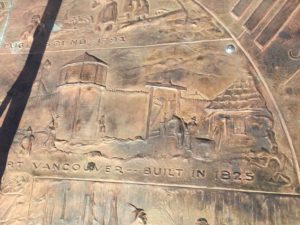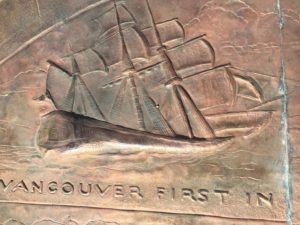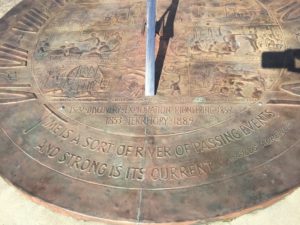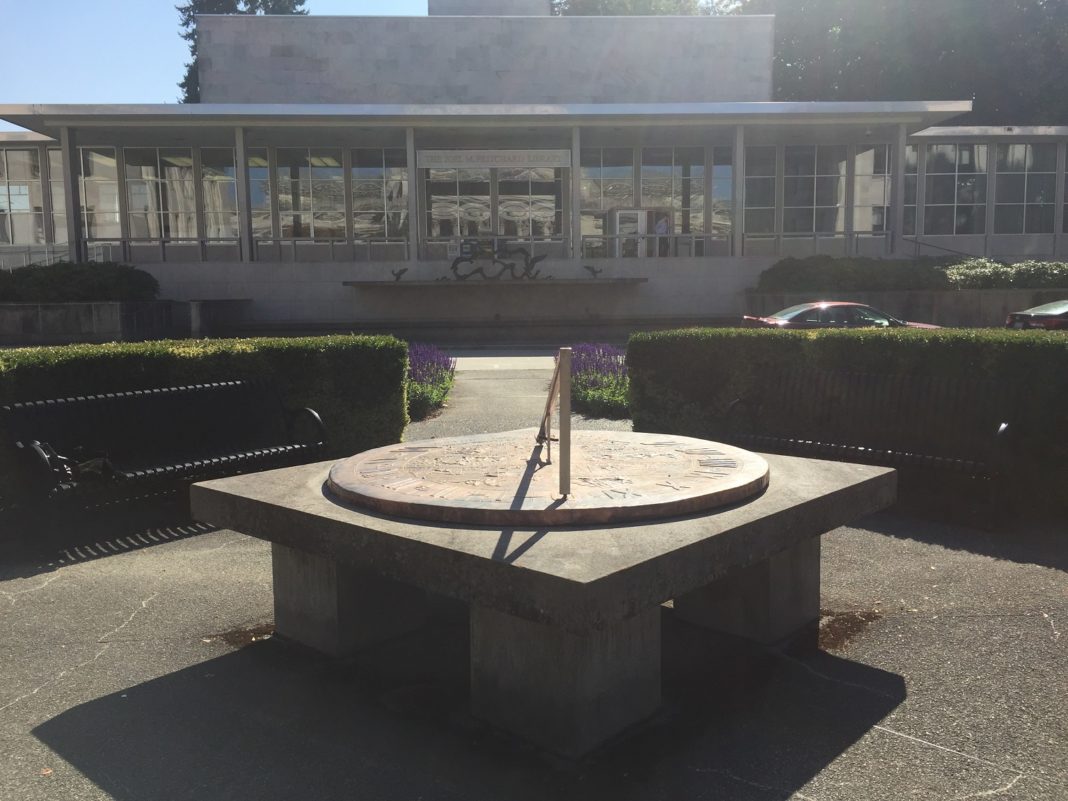The Washington State Capitol campus in Olympia is home to many fascinating, cultural and historical points of interest. One of these is the Territorial Sundial outside the Joel M. Pritchard Building, which formally served as the Washington State Library until it was relocated to Tumwater after the 2001 Nisqually Earthquake. Currently undergoing repairs, the sundial was created to commemorate the early history of the state for the library’s 1959 dedication.
 The Pritchard building was constructed in the late 1950s in the central core of campus to the south of the legislative building. Designed to commemorate and honor the history and artistic heritage of the state, the new library was decorated by several noted, contemporary Washington artists. They included John W. Elliott, Everett DuPen, Kenneth Callahan, Mark Tobey, James Fitzgerald and brothers Bob and Ira Spring.
The Pritchard building was constructed in the late 1950s in the central core of campus to the south of the legislative building. Designed to commemorate and honor the history and artistic heritage of the state, the new library was decorated by several noted, contemporary Washington artists. They included John W. Elliott, Everett DuPen, Kenneth Callahan, Mark Tobey, James Fitzgerald and brothers Bob and Ira Spring.
One commission went to the talented artist, John W. Elliott, to create an exterior sundial to mark the principal viewing point for the library at the center of a circular court between the identical O’Brien and Cherberg buildings. Born in Sheffield, England, Elliott was the son of a stone carver and modeler. Apprenticed as a silversmith for a short time, he studied design at Sheffield Technical School of Art (now part of the University of Sheffield). In 1906 he emigrated to the United States.

Moving to Seattle in 1921, he worked as an architectural sculptor. He specialized in metal repoussé (bas-relief done by hammering on the reverse side), ornamental plaster modeling, ecclesiastical metalwork and silversmithing. Much of his art is located in public buildings around the state. In the Olympia area he designed an eagle on the front façade of the Olympia Armory and created several repousse panels and two bronze plaques for the Olympia Brewing Company that are now housed in the Olympia-Tumwater Foundation archives at the Schmidt House.
The sundial Elliott was commissioned to create honors Washington’s history. The artist conferred with library architect, Paul Thiry, and state librarian, Maryan Reynolds, to pick the most fitting design. University of Washington reference librarian, Ronald Todd, prepared a detailed outline of regional history that Elliott used to pick events to represent. Elliott, Thiry and Reynolds finally decided which events would be in the finished piece. These focused on the early history of the area before statehood, which is why the piece is known as the Territorial Sundial.

The events depicted are:
- Captain Vancouver’s Explorations: the British naval captain who mapped the Pacific Northwest coast (1792).
- Fort Okanogan: an American fur trading post in what is now eastern Washington (1811).
- Fort Vancouver: the leading Hudson’s Bay Company trading post founded on the Columbia River by the British (1825).
- Cowlitz Convention: the meeting that called for a northern territory separate from Oregon Territory (1851).
- Crossing Naches Pass: the famous American wagon train crossing the Cascades Mountains (1853).
- First water-powered sawmill: the Hudson’s Bay Company logging mill near Fort Vancouver (1828).
- Medicine Creek Treaty: the first American treaty with Native Americans for south Puget Sound land (1854).
- First railroad to the Puget Sound (1883): the Northern Pacific Railway Company connects the Sound to a transcontinental railway network.
The finished, six-foot diameter sundial was made from two pieces of nineteen-gauge copper, mitered and reinforced on the back with braces and lugs. A gnomon, the piece that casts a shadow to tell time, was made from pounded copper rods labeled with an “N” to mark true north. The historical images are done in repoussé, hand-hammered by Elliott on the reverse side. The sundial rests on a Wilkeson sandstone base, the same type of stone used to face the outside of the Pritchard Building.

Around the edge of the sundial, zodiac signs and Roman numerals mark the time. As a finishing touch, a quote was added. There was some difficulty picking an appropriate one before Reynolds made the final selection: “Time is a sort of river of passing events, and strong is its current.” It is from the writings of Marcus Aurelius, a Roman emperor and philosopher.
The sundial was dedicated on January 23, 1959, along with the Washington State Library. As the sundial has marked the passing of time, time too has passed for the sundial. In the mid-1990s vandals destroyed the original gnomon, and state employees installed a temporary replacement. This summer the sundial was removed and taken to Seattle for evaluation and conservation. The sundial’s surface had bent, cupped and corroded. The Department of Enterprise Services is currently deciding between two options: restoring the original artwork or replicating it in bronze. In the later case the original piece would be put on interior display at the Washington State Library in Tumwater. Whatever the decision, the sundial is estimated to return to the state capitol campus around December 1, 2017. The Territorial Sundial will once again trace the passage of time.
Thanks to the Olympia-Tumwater Foundation’s curator, Karen Johnson, for information about John W. Elliott’s local artwork and the Department of Enterprise Services’ cultural resources manager, Marygrace Goddu, for images and information about current plans for the sundial.


















































